| Paterson Developing Tanks |
|
|
|
|
I decided to write this web page after receiving e-mails enquiring about predecessors of the current Paterson Super System 4 developing tanks. Was there ever a System 1, System 2 and System 3, to compliment the current System 4 ? I've owned a Paterson Major II tank since around 1960 and this set me wondering whether the II might be the 2nd tank series that ultimately lead to the System 4 (and then the Super System 4). Subsequently, I discovered there had been a Paterson Universal 3, a version I'd not previously heard about. Hence, with the original (c1949) Paterson tank, this showed a progression leading to the System 4. I thought it would also be
interesting to verify the claim that Paterson was the company
that invented the ball-bearing 'ratchet action' which simplifies
loading a film into the spiral (in total darkness) when a user
alternately contra-rotates the two ends of the spiral. |
|
| Click
the links for: Information on the First generation Paterson tanks, see here. Information on the Second generation Paterson tanks, the Series II Information on the Third generation Paterson tank, the Universal 3 Information on the Fourth generation Paterson tanks, the System 4 Information on the Fifth generation Paterson tanks, the Super System 4 |
|
|
Interestingly, much of the
product improvement of developing tanks over the 30 years documented
below is to do with two factors: Practical Photography magazine
in July 1962 did a
very thorough test of these tank agitation methods and their
full report can be downloaded
here. But their overall conclusion was surprising, both
to them and to any one who has been 'taken in' by the myth that
inversion agitation is a 'must'. They concluded: The author of this web page
adds: |
|
| Patents in the name of Donald MacDougal PATERSON | |
|
DONALD MACDOUGAL PATERSON is the named inventor on 30 patents relating to photographic equipment, published between 21st November 1951 and 6th September 1977. The full list can be seen here on the European Patent Office web site (esp@cenet). The earliest of Donald Paterson's patents relate to the inclusion of his famous 'ratchet action' to facilitate easier loading of film into the already well established film spiral used in photographic developing tanks. This patent, GB661,288, was published on 21st November 1951, but the original Application Date was "15th day of December, 1948". In this earliest patent, Donald Paterson describes the now familiar arrangement consisting of "a pair of spiral grooved plates, but instead of being rigidly fixed together the plates are arranged so that they can move independently on their common axis." However, this initial patent describes the ratchet loading of film into the spiral as being assisted by "a series of projections or teeth attached at intervals along the grooves." Although these teeth are described as "hinged or fixed, or moulded into the grooves or attached separately", there is no mention of the eventual use of ball-bearings working on inclines and held captive within small chambers at the entry of each spiral. Interestingly, it is the GENERAL ANILINE & FILM CORPORATION who, in a patent with an original Application Date of 7th February 1948 (albeit in the USA), first make mention of the ball bearing arrangement. Their 'bibliographic data' describes a "spiral groove, of which the outer groove wall is thickened and is formed on the inside with a recess containing a ball. When a film fed through openings into the groove passes (the) recess, the ball is moved into a larger part of the recess and permits the film to move into the spool. Should the film move in the opposite direction, (the) ball is moved into the narrower end of the recess and jams the film edge against the next groove wall. By relative movement of the discs in alternate directions, the film is moved step by step into the spool." This invention was filed as a GB patent (664,162) on 21st January 1949 and was published on 2nd January 1952. Thus, although the original filing of this patent (in the US) pre-dates the first from Donald Paterson, Donald's patent was published first. Donald Paterson's patent, GB661,356, "divided out of 661,288" has the same Application Date and Complete Specification Published Date as GB661,288 (above). This patent describes "A spool for receiving photographic film for treatment in a processing tank, comprises a pair of spaced coaxial plates rotatable relatively to one another about their common axis and each having on its inner face a spiral track defined by upstanding walls, said tracks having either their outer or their inner ends open for the insertion of the leading end of a film, and, located in at least one track, a captive roller working on an inclined plane forming one wall of the track, the upper end of the incline being towards the entry end of the track and the gap between such upper end of the incline and the opposite wall of the track being less than the diameter of the roller. Apart from the captive roller and the inclined plane, the spool is identical with that disclosed in Specification 661,288." The patent bibliography also states "Reference has been directed by the Controller to Specification 664,162." With only a lay understanding of patent law, I cannot claim to understand what legal point is made by the above "Reference by the Controller", but from a practical viewpoint it appears that the idea to use contra-rotating spiral ends together with some form of ratchet device to encourage the film along the spiral grooves, was invented almost simulataneously on both sides of the Atlantic. Alan Meek, Technical Manager of Paterson Products until 1981, e-mailed (March 2007) to say the near simultaneous invention of the self-loading film spiral in the UK and the US was genuinely a coincidence. "Paterson's tank at the time was for 35mm only and the film holder was referred to as a "spiral". As the backward-pointing teeth would only engage in the sprocket holes of 35mm film (Donald) Paterson wanted to create a spiral for roll film too and he came up with the idea of a ball-bearing in an inclined track. The track was a tiny moulding which was glued into the side of the spiral. As the side of the spiral was pushed forward the ball-bearing was forced into the narrow end of the incline and so gripped the film, to push it forward. When the side was spun the other way the ball-bearing moved into the wide end and released the film so that it could slide past. Ansco (General Aniline) in the USA happened upon the same idea at essentially the same time. Their patent held sway in the USA so for the next 16 years Paterson couldn't sell their tank there, while ANSCO had no access to UK markets. After that time Paterson did begin to sell into the USA, changing the word "spiral" to "reel", since the latter word was more intelligible to the Americans. Interestingly, Paterson used "reel" for its markets worldwide from then on, because it was more convenient to have just one package and instruction for all english-speaking markets. They changed from referring to "developing dishes" to "developing trays" at the same time and for the same reason." |
|
|
|
|
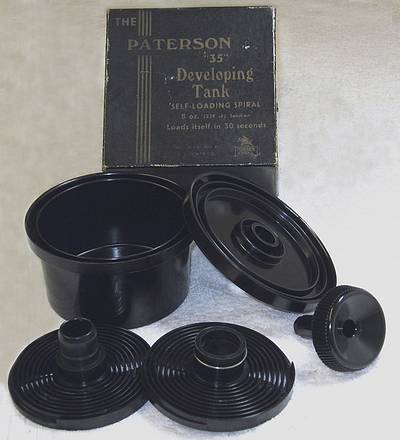 |
The original design of Paterson developing tank, the '35', is shown in an advert within the British Journal Photographic Almanac (BJPA) for 1950, where the distributors RF Hunter of "Celfix House", 51, Gray's Inn Rd, London, WC1, show 'The Paterson 35mm Ratchet Loading Developing Tank' at the base of p415. "This is the Miniature Man's "Must". A 35mm developing tank with a ratchet spiral which really loads itself." The box lid claims "Loads itself in 30 seconds". Because the BJPA covers the previous years' products, it is likely that this first Paterson tank was available before the end of 1949. This would fit with the understanding that late in 1948 Donald Paterson patented his special self-loading spiral. The tank required 8 fluid ounces for a 36exp, 35mm film (230cc).  |
 |
Developing tanks were the very first item of Paterson darkroom equipment. The lid, apart from having bold white text, also has the moulded text "Made in England" and opposite "Patent Pending". The first generation Paterson tank had no inversion agitation. It was filled through a central funnel and emptied through a peripheral spout. But it did have an oscillatory motion 'self-loading' spiral, albeit using fixed 'fangs' on the spiral entry to provide the desired ratchet effect (see below), rather than the subsequent captive 'ball-bearing' arrangement. I understand from Alan Meek, Technical Manager of Paterson Products until 1981, that Donald Paterson initially used the idea of fixed 'fangs' (gained from one of his safari expeditions), because they could engage with the edge sprocket holes of 35mm film and so assist the film into the spiral. Alan Meek also told me that the original 35mm spirals were moulded from phenolic (Bakelite) plastic which was a bit rough and hindered easy loading. The later ones were moulded from polystyrene, which was smoother and could also be translucent clear, so that transparency film could be processed without having to remove the film from its spiral to enable it to receive its second exposure. |
 The instruction booklet for this earliest Paterson tank can be downloaded as a pdf here, or by clicking on the small image alongside. The booklet is courtesy of Molli Chambers, in Victoria, Australia. |
|
 Upper spiral. |
 Lower spiral. |
| PhotoGuide Magazine for August 1952 describes the early ratchet system as: "...small projections near the entrance of the groove which engage the perforations of the film and help to pull it in at alternate sides as the top section (of the spiral) is rotated to and fro. Additional ratchets about half-way inside the groove ensure even loading and prevent jamming of the film". | |
| The same PhotoGuide review tells of a change to the agitation rod of the Paterson 35 by August 1952 (though the modification may have been introduced earlier, perhaps around the same time as the Paterson 'Major' tank became available). Instead of a loose fit hexagonal end that engaged with a similar shape in the lower end of the spiral (see below, left), it now had a slightly tapered stem (see below, right) which, when pushed down inside the central core of the film spiral, gripped sufficiently by an interference fit inside the core, to allow the whole spiral with its immersed film to be lifted a few millimetres, by pulling upwards on the funnel, and subsequently lowered again, therefore "giving efficient two-way agitation", i.e. both rotary and up & down. This was the first stage of improving agitation during film development that led to total inversion agitation by the second tank Series. | |
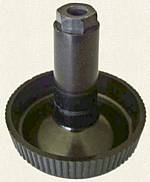  |
 |
| During 1950 the Paterson '35' tank was joined by the Paterson 'Major' tank. The 'Major' version was designed for roll film use, taking film sizes 127, 120/620 and 116/616. Roll films have no sprocket holes, so in order to provide a similar self-loading action for roll films as with perforated 35mm film, the use of a ball-bearing ratchet was introduced, see below. | |
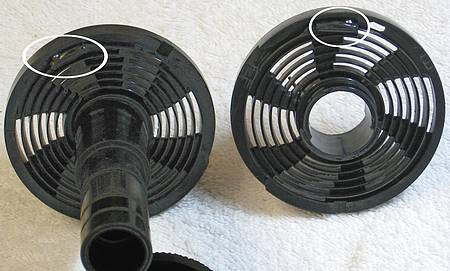 |
The white arrows have been superimposed on the above photographs to show the direction of film movement, past the ball-bearings. The left hand is the lower spiral, carrying the spiral centre column, and the right hand picture is the top, adjustable, spiral. |
| The BJPA for 1951 reviews both the '35' and the 'Major' and confirms that the 'Major' tank was equipped with a 'ball-bearing' action to grip on the edges of the unperforated roll film, outside the picture area. This tank also incorporated up-and-down, as well as rotary, agitation of the film, by the same method as described above for the revised version of the Paterson '35' and also the Universal tank (see later, below). | |
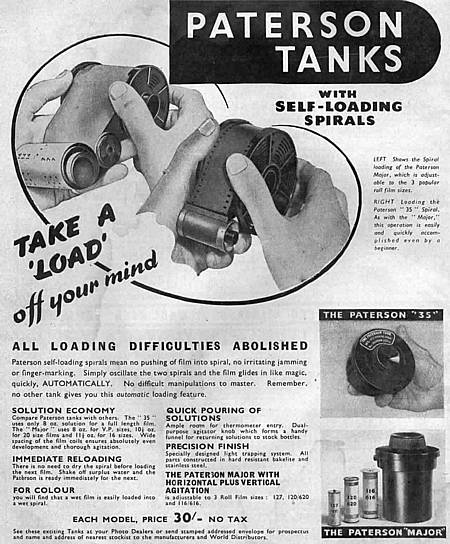 |
Above is shown the four components of a Paterson Major adjustable roll film tank. The top spiral moves up and down relative to the lower spiral by pulling back on the wire spring clip. When the clip is released it engages with one of 3 notches (one for each film size; 127, 120/620, 116) which keeps the spiral halves a fixed distance apart but still allows them to rotate approx. a half circle with respect to each other, so enabling the self-loading action. The BJPA review claimed "both wet and dry films may be loaded in these tanks with absolute certainty - a matter of some convenience in certain colour processes" (referring to colour reversal second exposure). The PhotoGuide review in August 1952 adds the important caveat that "wet films can also be loaded into the reel under water..." |
|
The advertisement above is taken from Amateur Photographer (AP) magazine for March 7th 1951 (p8). Both sizes of tank are priced the same, at 30/- (£1.50p) and NO TAX. Thermometers for the '35' (4" long) cost 3s.6d (17.5p) and for the 'Major' (6") cost 5s (25p). By 1953, 'Photography' magazine included regular RF Hunter advertisements for these two tanks, backed by recommendations from eminent photographers of the day. In the April issue it is H.S.Newcombe, FRPS; in July it is Alec Pearlman, FIBP, FRPS; in September it is Lancelot Vining, FIBP, FRPS "I wish I could have had it in Fleet St in the early days of 35mm photography, when sticking film in the ordinary spiral tank was a daily nightmare". |
|
 |
The two original Paterson tanks, in the BJPA for 1953 (see far left). The 'Major' & its box (left). |
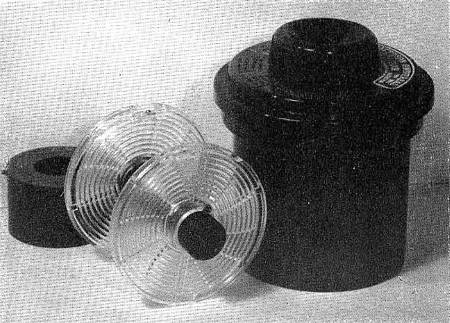 |
A 1954 test review of the Paterson Universal tank (Modern Camera Magazine, Nov.1954) illustrates a transparent film spiral with ball bearing ratchets and states that this is the same 'ingenious self-loading spiral' as fitted to the previous two Paterson tanks. The reviewer commented on the highly polished polystyrene plastic, impervious to all photographic chemicals. The tank cost 32/6d (£1.63p). The agitating rod is combined with a funnel. "The lower end of this agitator is slightly conical, and adheres to the inner surface of the spiral core, so as to enable vertical agitation to be added to the usual rotating movement". "Emptying takes 20 seconds for the 17.5 fluid ounces necessary when developing 120 roll film. The spout is free pouring with no tendency to dribble". The transparent end cheeks of the spiral enabled, for the first time, the second exposure of reversal colour films to be carried out without removing the film from the spiral - "a very valuable feature". "A first class tank, which will be widely welcomed by colour users". |
|
|
The Universal could take a full length 35mm film as well as 127, 120/620 and 116/616 roll films. To avoid excessive use of solutions when developing the shorter roll films, a 'solution economiser' was available to fit around the central core of the spiral and reduce the solution volume by 3.5 fluid ounces [20fluid ounces = 1pint = 568cc]. 35mm film required 11 fluid ounces; 127 required 14 fl.ozs (10.5 fl.ozs with the economiser), 120/620 required 17.5 fl.ozs (14 fl.ozs with the economiser) and 116/616 required 19.5 fl.ozs. Alongside is shown an 'Economiser' for use when processing 120/620 roll film. Just a hollow, internally weighted, black polystyrene cylinder manufactured in England by RF Hunter Ltd. There was also an economiser for similarly reducing the solution volume when developing 127 films. Economisers cost 2s/6d (12.5p) each. |
|
|
|
|
Also shown in the 1940 BJPA (illustrated left) was a Johnson's tank sized to take a full length 35mm film and holding 16 fluid ounces. The BJPA went to some trouble describing the "striking and very useful calculator" on the tank lid (as the later J-20 tank, see below). This calculator could be set to remind the user of the developing time required for films at 65°F (black figures) or 70°F (red figures). Naturally, the caculator favoured the instructions for Johnson's developers suited to miniature film (as 35mm was referred to). These were Johnson's 'Fine Grain' , 'Super Fine Grain', 'Meritol-Metol' and M.C.M. 100'. The tank was priced at 20s (£1), nearly £80 in 2022. Clearly the amateur photographer using 35mm film at that time was thought likely to be fairly affluent. |
|
|
This is a Johnson J-20 (& Nebro) tank. The disk on the lid is rotatable against a fixed arrow to assist calculating time versus temperature for Johnson developers. It is an early version J-20 (marketed from 1947) before introduction, around 1950, of the "new spring loaded spiral giving two-way agitation". The J-20 price was £1.5s (£1.25p) by the early 1950s. |
Around 1950/51 Johnsons of Hendon were phasing in a range of tanks with their new 'Roto-Feed' feature. This was described as follows. "The top section of the spiral is free to rotate about 3/4" (20mm) in either direction. By rotating the two halves (of the spiral) in relation to each other whilst applying alternating light pressure with the thumbs on the edge of the film, it can be fed in almost automatically." Clearly this is a simpler, though less positive, means of achieving assistance in feeding the film into the spiral than using the Paterson ball-bearing ratchet arrangement. The 'Roto-Feed' feature first appeared in the redesigned Universal tank, which took all sizes of roll film (127, 120/620, 117, 116/616) as well as 5ft lengths of 35mm or 16mm. It cost £1.9s (£1.45p) in 1950 but a year or so later it increased to £1.12s.6d (£1.63p). This occurred around the time that 'Roto-Feed' was added to the Johnson 35mm tank; its price increased from £1.6s.6d to £1.12s.6d. The J-20 tank, only for 120 films, never received the 'Roto Feed' feature, and was replaced towards the end of 1954 by the 'Polly-Min' tank with its 'Roto-Feed' transparent spiral. The Universal was then replaced by the 'Polly-Max' (see below). |
 |
For a pdf file
of the instruction book for the earliest Johnson tank, pre-1947,
click here
or the image. An earlier version of this instruction boolet, but still post-WW2, has prices typically 5-10% lower. |
  |
These pictures, sent to me by Carl Garner, seemingly show a display version of the Johnson Universal tank, as described in the instruction booklet above. It took all roll film sizes from 116, 120 and down to 127, and also 35mm, though the spiral only had sufficient coil length to accommodate an 18 exposure 35mm film. This display model is fixed to a wooden plinth, presumably serving as a marketing tool. Carl says "I picked it up for the princely sum of £1.50 at a car boot sale ......It is complete with its internal spiral and its agitation rod". Later versions of the Universal tank, from around 1950, had a spiral that could accommodate a full length of 36 exposure 35mm film. Hence, this display model dates from before 1950 and perhaps pre-1947. The manufacturers are named as Johnsons, Hendon, and not Johnsons of Hendon, as they became in 1948. |
  |
The photograph of the spiral and accompanying diagram (left) shows the means by which vertical agitation was added to the J-20 and all other Johnson (& Nebro) tanks around 1950. Pressure on the agitation rod depressed the spring and forced the solution up through the coil of film, thus it enabled both vertical and rotary agitation. |
 |
This instruction booklet (dated 1953) for the later J-20 tank, with its spring loaded vertical agitation but still no Roto-Feed, can be downloaded by clicking the image or here. |
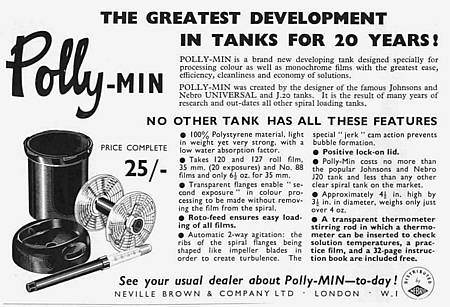 |
The Polly-Min tank was first introduced towards the end of 1954. The same Modern Camera Magazine (MCM) July 1955 edition that introduced the Paterson Major II, also contained a Neville Brown advertisement for the Polly-Min tank, "by the designer of Nebro and Johnsons tanks". In the 1954 'MCM' magazine its design is attributed to Willi Soukop 'the well known sculptor'. It had 'Roto-feed' for easy loading and also transparent spiral flanges, but no inversion agitation or easy central pouring. ['The Nebro story', from the late 1930s through to 1963, was told by Eric Lock in Photographica World magazine, 2006/1] It could process the same range of films as the Paterson Major II and took the same quantity of solution (185cc to 300cc). At 25/- (£1.25p) the distributors claimed it "cost less than any other clear spiral tank on the market". There was also a Polly-Max enabling the simultaneous developing of 2 roll films (end to end, see below) priced at 32s/6d (£1.63p). Made of Polystyrene, "more suitable than the older phenolics". |
|
|
Making full use of the 'Polly' name by illustrating the box front with a cartoon parrot, the Polly tanks were displayed in a bright, eye-catching, carton. The inside box flap states that "Polly tanks & accessories are distributed to the trade jointly by Johnsons of Hendon Ltd & Neville Brown & Co. Ltd" (Nebro).
Owners of the Polly-Max tank could purchase an Intermediate Carrier spiral, enabling two full length, or four 20 exposure, 35mm films to be developed at the same time. It cost 12s 6d (62.5p). |
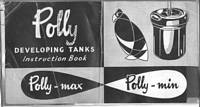 |
Click on the instruction booklet opposite, or here, to download a pdf file for both the Polly-Min and Polly-Max tanks. Be patient as the file is 3.8MB. |
|
|
|
| The first of Paterson's second generation developing tanks was the Major II, first shown at the British Photo Fair, May 16th to 21st 1955, on the stand of distributor R F Hunter Ltd (stands 32-35) at New Horticultural Hall, London, S.W.1. | |
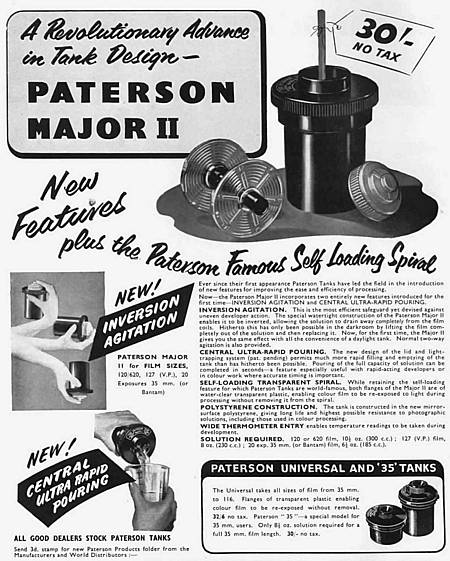 |
"Now - the Paterson Major II incorporates two entirely new features introduced for the first time - Inversion Agitation and Central Ultra-Rapid Pouring." So proclaimed the RF Hunter advertisement in 'Modern Camera Magazine' (MCM) for June 1955 (p224). It also incorporates a transparent spiral, enabling the film's second exposure to light, as required during processing colour slides, to be performed without removing the partially processed film from the spiral. The transparent spiral had been introduced perhaps 6 months earlier (Nov 1954) with the Universal tank. Suitable for film sizes 120/620 roll films (300cc of solutions required), 127 roll film (230cc) and 20exp. lengths of 35mm (including Bantam) film (185cc). It cost 30/- (£1.50p). Notice that the Universal and the '35' tanks are available but still in their original versions. But this was to change for the '35' during 1955 with the introduction of the '35' II, also with a transparent spiral. Thus, all Paterson tanks had transparent spirals before the end of 1955. The Universal tank, however, remained in its original style until into 1956 or early 1957. |
|
|
Alongside is my Major II tank, which I've owned and used MANY times since the early 1960s. Its easy to load and economical on developer. I also like the small removable top to the inversion agitation cap, which allows a thermometer to be inserted during development without the need to pull the entire sealing cap off. The grey, serrated topped, agitation rod provides the same facility as was introduced around the time of the original Major tank (see above) of being slightly tapered, enabling it to grip inside the spiral central core and provide means to both lift the spiral a few millimetres as well as to rotate it. This is done when the developer is first poured in, but after that the water-tight cap is pushed on and agitation is subsequently by total inversion.
|
 For a pdf file of the instruction book
for the Major II tank, click here or the image. For a pdf file of the instruction book
for the Major II tank, click here or the image. |
|
 |
The next stage in marketing the second generation Paterson tanks is illustrated in the BJPA for 1956. There are now 3 Major II tanks, the original, a Double and a Triple. The original '35' has disappeared and been replaced with the '35' II and a Triple '35' II has been introduced, enabling developing either a single 35mm film or, in the Triple, up to 3 full length 35mm films to be developed together. The Paterson Universal remains as in 1954.
|
 |
The RF Hunter advert in the
BJPA for 1957 shows, for the first time, a complete line of inversion
agitation Series II tanks. Even the Universal is now the Universal
II (see lower LH corner of advert alongside). There are 3 tanks in the Major II range and 2 in the '35' II range, being a single '35' II and a Triple '35' II. RF Hunter make various claims
for this tank series: Inversion agitation is claimed to be "the most certain way of overcoming uneven development marks and streaks, especially when using rapid-acting developers and the newest thin base high resolution films." |
 |
Nothing changes in the Series II tank range between the BJPA 1957 advert (above) and that shown in AP for 16th May 1962, alongside. This situation continued through to (at least) 13th August 1963 (Ref: AP magazine advert) Prices quoted in spring 1962
are: A Paterson force film washer "for efficient film washing", cost 4s.3d (21p). "Made in England for World Distributors:- R F Hunter Ltd, Celfix House, 51-53 Gray's Inn Road, London, WC1" |
|
|
|
 |
An advert in AP dated 5th October 1960 shows that Johnsons of Hendon had caught up with Patersons insomuch as they were then offering their Roto-One (30/-) and Roto-Two (32/6d) tanks with inversion agitation. These tanks must have replaced their previous non-inversion Polly-Min and Polly-Max tanks (see above). As with the Polly tanks, the Roto tanks included a form of assisted loading called "Roto-feed" and the spirals were transparent for easier transparency (colour and b&w) film processing. The Roto-Two tank had three advantages over the equivalent Paterson Universal II.
In 1962, this design of tank
was also sold as the Nebro 10 and Nebro 21 by Neville Brown,
priced 25s (£1.25p) & 27s (£1.35p) respectively,
so undercutting the price of the Johnsons equivalents. The additional
central spiral, to facilitate additional 35mm films, still cost
12s.6d.
To download a pdf of the original Roto-Two instruction booklet, click on the cover image or here. Box and instructions available courtesy of Brian Rees. |
|
|
The box for the Nebro (Neville Brown) version of the Roto-Two, the Nebro 21. This picture has been sent to me by Phil Birch. In 1963 the Polly-Max tank, previously sold by Johnsons and by Nebro (see above), was still being sold by Nebro in parallel with their Nebro 21 (and Nebro 10) tanks, but now named the 'Nebro Popular Developing Tank'. It was (then) available at the reduced price of 18shillings (90p). It accepted the same internal parts as the Nebro 21 so that spares were readily available. |
|
The Johnson Universal developing
tank, shown below from AP magazine dated 18th September 1963,
was selected for display at the Design Centre, London. "Designed
by practical photographers to do a better job." Percy W Harris Hon.FRPS, FPSA extolled it as "The biggest advance in tank design since the introduction of the spiral tank." (Percy.W.Harris editor of Modern Camera Magazine (MCM), died during 1963). Despite all the 'hype', the differences and advantages compared to e.g. the Roto Two tank (above) are difficult to see. Indeed, there is no longer an option to use a central spiral to double up the number of (35mm) films that can be developed, though the facility to develop 2 off 120/620 or 127 films simultaneously, by loading them end to end, remained. The facility to develop the large 116 film size had been dropped. The design included an additional sealing ring, where the top screwed onto the tank body, and was claimed to have a large filling funnel and novel light-trapping, the latter enabling avoidance of solution 'spluttering' during rapid poured in. It was priced at 32s.6d (£1.63p). |
|
 |
 |
|
|
|
 |
It seems there was only one tank within the Series III. This was the Universal 3, advertised in AP for 9th September 1964 (p88). "This new model of the famous Paterson Universal Tank embodies years of unrivalled experience......" It offered much the same as the Universal II, but also had the facility to develop 16mm sub-miniature (still camera) films and (in later adverts, but may not have required any modification) the 'new' 220 film size*. On the 'downside', it no longer took 116 film. It required 480cc to cover the spiral loaded with 120 or 620 film, 370cc for 127, 290cc for 35mm and 160cc for 16mm. The Universal 3 cost the same as the Universal II, at 32s.6d. (£1.63p) The Series II tanks (other than the Universal II) were still available as late as spring 1968 (AP, 8th March edition, p47) alongside the Universal 3. The Paterson force film washer was then 5s (up from 4s.3d in 1962). |
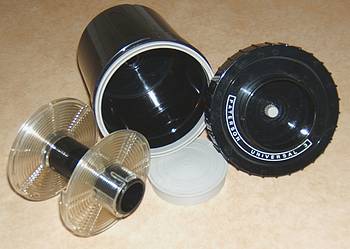 |
RF Hunter claimed "an extra wide neck, permitting rapid filling and emptying of solutions." It also incorporated "A polythene sealing ring (between body and screw on top) which greatly assists in preventing leakage of solutions during inversion." "Full length 35mm films are assisted (to load) by the introduction of a ratchet tooth which engages in the perforations and operates in conjunction with the ball-bearing action". Unlike the Universal 3, the Series II tanks did not have an additional sealing ring between the tank body and the screw on top lid (though my experience with the Major II is that leakage is not a great problem and even my System 4 tank isn't perfect in this respect). |
| *220 film
enabled 24 6x6cm pictures on a 120 sized spool; 220 only used
a paper leader and trailer - there was no backing paper behind
the film, enabling a greater lengh of light sensitive film within
the same spool diameter. I believe 220 film first appeared in
the UK in 1966 (it is mentioned in the March 1966 edition of
Camera Magazine). But Camerapedia says 220 was introduced in 1965,
so possibly Kodak introduced the film earlier in its native USA.
Practical Photography, May 1965, announced that Rollei Werke
Franke & Heidecke in Braunschweig, W.Germany, had prepared
a modification enabling their twin lens reflex cameras to use
the new film and Kodak expected the film to be available in Germany
for spring 1965. ANSI - American National Standards Institute ANSI PH1.21: Photography (Film) Roll Film Sizes 120 & 220 - Dimensions (Superseding Document: ANSI IT1.21). ANSI PH1.38: Dimensions / Size 220 Roll Film with Paper Leader & Trailer (Superseding Document: ANSI PH1.21) |
|
|
The Paterson Universal 3 was contemporary to the Johnson Universal tank (see above) and offered much similarity of design and facilities. Even the prices are identical. Since RF Hunter became a subsidiary of Johnsons of Hendon around the mid-1960s and Johnsons took over distributing Paterson equipment from RF Hunter around 1967, it seems possible there was design collusion between the various parties. It was noted above that Johnsons of Hendon and Neville Brown's company 'Nebro' had marketed the same Polly Min and Polly Max developing tanks and by 1962 Nebro were selling their '10 and '21' tanks in competition with Johnson's Roto-One and Roto-Two. But this friendly rivalry ceased thereafter, when Nebro came into financial difficulties and were taken over by the Pullin Optical Company Ltd. Nebro continued to trade under its own name until around 1965, when both Pullin and Nebro were acquired, and then became lost within, Rank Photo. Just prior to this, in 1964, Nebro had seemingly reverted to selling the previous Polly-Min tank as the Nebro 'Popular', at the reduced price of 18s (90p). |
|
|
|
|
  |
The 'Paterson Tank System 4'
was introduced in 1968. As shown alongside, there were 5 tanks in the range. The film spirals (now called 'reels' to suit the American market and enable the packaging & instructions to be unified across all English-speaking markets) are made of acetal resin (nylon) for smooth loading, high heat resistance (allows rapid heated drying) and extreme resistance to photographic chemicals. They universally fit all the System 4 tanks. The tank body and top are of polystyrene. The smallest tank is the 35mm, taking a full length 35mm (or 126) film, and cost £2.24p in 1973. Next is the Universal, capable of processing full length 35mm to 120/620 roll films. With two spirals, it can process 2 off 35mm at the same time. Cost (with one spiral) was £2.41 in 1973. Multi-Unit Tanks are sold without spirals as the number and type of spirals "may vary with individual requirements". Multi-Unit 1 holds up to 3
35mm, 2 127 or 2 120/620 films |
 For a pdf file of the instruction book
for the System 4 tank, click here or the image. For a pdf file of the instruction book
for the System 4 tank, click here or the image. |
|
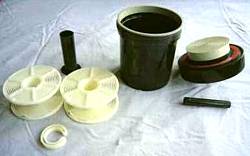 |
From 1970 onwards (see below) a second type of spiral became available. The conventional edge loading type was complimented by a 'new' (though by no means novel) centre loading variety - identifiable by having a spring clip on its central stem. To load the reel, the film is clipped to the central shaft of the spiral. The design requires the film to be momentarily bent lengthwise as it is loaded, so as to reduce the film width and allow it to 'spring' into the central spiral groove. Therafter, it is wound into the groove of the spiral, much as with a spiral that loads from the outside, but starting from the groove centre. |
|
Adjustable for all film sizes (35mm to 120/220). Cost 18s.6d each, (93p) distributors (now) being Johnsons of Hendon. |
AP for 7th January 1970, on their 'What's New' page, describe the System 4 as popular because "these tanks offer standardised lids, spirals and other components, which allow a system to be built up to suit individual requirements. The system is now further extended by an entirely new design of centre-load spiral." (Also visible in the 1973 Paterson brochure picture, above) To load the spiral, the leading edge of the film is pushed under a stainless steel clip on the centre core, which holds the film securely and without any risk of damage. The film is held by its edges and the spiral rotated, winding the film into the grooves from the centre outwards. AP found these centre loading spirals loaded easily and (in common with the normal type) felt firm at their widest setting. |
|
|
|
 |
The Paterson 'Super System 4' tank series appeared in late 1981 (Ref: Photography magazine, December 1981). The picture alongside is taken from a Paterson brochure of darkroom equipment dated 1984, showing the five tanks plus some accessories. The reels (only) are interchangeable with the previous System 4 tanks, but this presumably explains why the name 'System 4' is retained. The Super System 4 tanks are physically larger than the System 4 due to the design of the lid being a large funnel with no sealing ring to trap chemicals and no screw thread to 'cross'. The lid is turned until a loud click is heard, whereupon it is secure and light tight. A snap-on PVC cap covers the whole of the top of the tank, making it water-tight for inversion agitation. Despite their apparent larger size, they cost the same and used the same volume of chemicals, as the System 4 tanks. "Simpler to load, faster to fill and easier to clean than any other tank. The large diameter one piece lid and funnel clip into place securely and positively. A water-tight PVC cap seals the top of the tank to prevent leakage during inversion." The five Super System 4 tanks
comprise: All 'auto-load' reels are adjustable to take 35mm, 126, 127, 120 and 220 films. They use the unique twin-ball ratchet system for easy film loading. |
| AP, for 30th July 1983, in their News Shorts page, report "Paterson's Super System 4 developing tanks have become Britain's top selling items in this field, and the success is being repeated overseas. Now Super System 4 cartons are being printed in English, French, German, Spanish, Arabic, Japanese and Mandarin! Over 35 percent of Paterson's total exports are being sent to the Far East". | |
  |
  |
|
A Paterson Photax Group advertisement in Practical Photgraphy magazine for December 1992 reading "Great Gift Ideas from Paterson Photax", showed the picture left, which offers a free Super System 4 film reel "worth £8.49" to purchasers of a Super System 4 tank "to mark 2 million tank sales". |
|
|
|
|
|
|
|
||
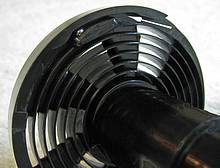


 The
1940 BJPA (hence could date to 1939) Johnson's (prior to them
becoming Johnsons of Hendon) introduced "The first all-British
developing tank". Adjustable to suit roll films sized 116,
120, 117 aand 127, or an 18 exposure length of 35mm. Made of
Baakelite "of excellent surfce qualities and resistant to
chemical action". It was possible to separately purchase
the internal film holding spirals, called "bobbins"
and also separately purchase the outer bodies in different colours
to identify their use for developing, fixing or washing the films.
The price, complete was 16s (80p), equivalent to a significant
£60 in 2022.
The
1940 BJPA (hence could date to 1939) Johnson's (prior to them
becoming Johnsons of Hendon) introduced "The first all-British
developing tank". Adjustable to suit roll films sized 116,
120, 117 aand 127, or an 18 exposure length of 35mm. Made of
Baakelite "of excellent surfce qualities and resistant to
chemical action". It was possible to separately purchase
the internal film holding spirals, called "bobbins"
and also separately purchase the outer bodies in different colours
to identify their use for developing, fixing or washing the films.
The price, complete was 16s (80p), equivalent to a significant
£60 in 2022. This
diagram from the instruction booklet shows how the Polly-Max
tank could take two 20exp.35mm or two 127 or two 120 roll films.
With both 'Stops' pulled UP, the spiral groove (top & bottom)
is unobscured and the first film is loaded & pushed right
to the centre of the spiral. Then (still in darkness) the two
nylon 'Stops' are pushed DOWN and the second film loaded without
danger of it overlapping the first.
This
diagram from the instruction booklet shows how the Polly-Max
tank could take two 20exp.35mm or two 127 or two 120 roll films.
With both 'Stops' pulled UP, the spiral groove (top & bottom)
is unobscured and the first film is loaded & pushed right
to the centre of the spiral. Then (still in darkness) the two
nylon 'Stops' are pushed DOWN and the second film loaded without
danger of it overlapping the first. All
tanks now have transparent 'self-loading' spirals, seen here
with a '35' II tank.
All
tanks now have transparent 'self-loading' spirals, seen here
with a '35' II tank.

 With either design of spiral, a firm
twist of the two halves frees them to allow adjustment to the
required film width, and a second (contra) twist locks the halves
securely in the selected position.
With either design of spiral, a firm
twist of the two halves frees them to allow adjustment to the
required film width, and a second (contra) twist locks the halves
securely in the selected position. On Tuesday 23rd June 1992 Paterson
celebrated the production of the two-millionth Super System 4
Universal developing tank. The tanks were then being sold with
a lifetime replacement warranty. (Ref: PhotoPro magazine, Vol.2
No.2, 3rd Quarter 1992, ProNews, p6.
On Tuesday 23rd June 1992 Paterson
celebrated the production of the two-millionth Super System 4
Universal developing tank. The tanks were then being sold with
a lifetime replacement warranty. (Ref: PhotoPro magazine, Vol.2
No.2, 3rd Quarter 1992, ProNews, p6.